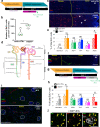Telomerase is required for glomerular renewal in kidneys of adult mice
- PMID: 35149726
- PMCID: PMC8837629
- DOI: 10.1038/s41536-022-00212-z
Telomerase is required for glomerular renewal in kidneys of adult mice
Abstract
Homeostatic renal filtration relies on the integrity of podocytes, which function in glomerular filtration. These highly specialized cells are damaged in 90% of chronic kidney disease, representing the leading cause of end-stage renal failure. Although modest podocyte renewal has been documented in adult mice, the mechanisms regulating this process remain largely unknown and controversial. Using a mouse model of Adriamycin-induced nephropathy, we find that the recovery of filtration function requires up-regulation of the endogenous telomerase component TERT. Previous work has shown that transient overexpression of catalytically inactive TERT (i-TERTci mouse model) has an unexpected role in triggering dramatic podocyte proliferation and renewal. We therefore used this model to conduct specific and stochastic lineage-tracing strategies in combination with high throughput sequencing methods. These experiments provide evidence that TERT drives the activation and clonal expansion of podocyte progenitor cells. Our findings demonstrate that the adult kidney bears intrinsic regenerative capabilities involving the protein component of telomerase, paving the way for innovative research toward the development of chronic kidney disease therapeutics.
© 2022. The Author(s).
Conflict of interest statement
The authors declare no competing interests.
Figures








Similar articles
-
CXCL12 blockade preferentially regenerates lost podocytes in cortical nephrons by targeting an intrinsic podocyte-progenitor feedback mechanism.Kidney Int. 2018 Dec;94(6):1111-1126. doi: 10.1016/j.kint.2018.08.013. Epub 2018 Oct 29. Kidney Int. 2018. PMID: 30385042 Free PMC article.
-
Autophagy is activated to protect against podocyte injury in adriamycin-induced nephropathy.Am J Physiol Renal Physiol. 2017 Jul 1;313(1):F74-F84. doi: 10.1152/ajprenal.00114.2017. Epub 2017 Apr 12. Am J Physiol Renal Physiol. 2017. PMID: 28404589 Free PMC article.
-
Notch activation differentially regulates renal progenitors proliferation and differentiation toward the podocyte lineage in glomerular disorders.Stem Cells. 2010 Sep;28(9):1674-85. doi: 10.1002/stem.492. Stem Cells. 2010. PMID: 20680961 Free PMC article.
-
Targeting podocyte-associated diseases.Adv Drug Deliv Rev. 2010 Nov 30;62(14):1325-36. doi: 10.1016/j.addr.2010.08.012. Epub 2010 Sep 7. Adv Drug Deliv Rev. 2010. PMID: 20828590 Review.
-
[The role of podocyte damage in the pathogenesis of glomerulosclerosis and possible repair mechanisms].G Ital Nefrol. 2009 Nov-Dec;26(6):660-9. G Ital Nefrol. 2009. PMID: 19918748 Review. Italian.
Cited by
-
Noncatalytic telomerase function in inflammation.Nat Cell Biol. 2025 Aug;27(8):1206-1207. doi: 10.1038/s41556-024-01497-6. Nat Cell Biol. 2025. PMID: 40770486 No abstract available.
-
Renal tubular epithelial cell quality control mechanisms as therapeutic targets in renal fibrosis.J Pharm Anal. 2024 Aug;14(8):100933. doi: 10.1016/j.jpha.2024.01.001. Epub 2024 Jan 3. J Pharm Anal. 2024. PMID: 39247486 Free PMC article. Review.
-
Evolutionarily conserved role of telomerase reverse transcriptase in programming the microenvironment via regulation of the cGAS-STING pathway.Nat Cell Biol. 2025 Aug;27(8):1342-1356. doi: 10.1038/s41556-025-01706-w. Epub 2025 Aug 6. Nat Cell Biol. 2025. PMID: 40770487
-
Exploring the impact of diabetes on aging: insights from TERT and COL1A1 methylation.Turk J Biol. 2024 Jun 26;48(4):257-266. doi: 10.55730/1300-0152.2701. eCollection 2024. Turk J Biol. 2024. PMID: 39296334 Free PMC article.
-
mTert induction in p21-positive cells counteracts capillary rarefaction and pulmonary emphysema.EMBO Rep. 2024 Mar;25(3):1650-1684. doi: 10.1038/s44319-023-00041-1. Epub 2024 Feb 29. EMBO Rep. 2024. PMID: 38424230 Free PMC article.
References
-
- Go AS, Chertow GM, Fan D, McCulloch CE, Hsu CY. Chronic kidney disease and the risks of death, cardiovascular events, and hospitalization. N. Engl. J. Med. 2004;351:1296–1305. - PubMed
-
- Wiggins RC. The spectrum of podocytopathies: a unifying view of glomerular diseases. Kidney Int. 2007;71:1205–1214. - PubMed
-
- Nagata M. Podocyte injury and its consequences. Kidney Int. 2016;89:1221–1230. - PubMed
LinkOut - more resources
Full Text Sources
Other Literature Sources
Molecular Biology Databases

